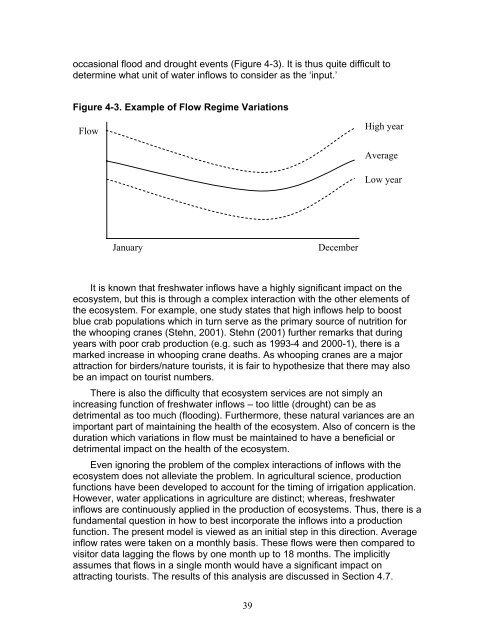The Economic Value of Water and Ecosystem Preservation
The Economic Value of Water and Ecosystem Preservation
The Economic Value of Water and Ecosystem Preservation
Create successful ePaper yourself
Turn your PDF publications into a flip-book with our unique Google optimized e-Paper software.
occasional flood <strong>and</strong> drought events (Figure 4-3). It is thus quite difficult to<br />
determine what unit <strong>of</strong> water inflows to consider as the ‘input.’<br />
Figure 4-3. Example <strong>of</strong> Flow Regime Variations<br />
Flow<br />
January December<br />
It is known that freshwater inflows have a highly significant impact on the<br />
ecosystem, but this is through a complex interaction with the other elements <strong>of</strong><br />
the ecosystem. For example, one study states that high inflows help to boost<br />
blue crab populations which in turn serve as the primary source <strong>of</strong> nutrition for<br />
the whooping cranes (Stehn, 2001). Stehn (2001) further remarks that during<br />
years with poor crab production (e.g. such as 1993-4 <strong>and</strong> 2000-1), there is a<br />
marked increase in whooping crane deaths. As whooping cranes are a major<br />
attraction for birders/nature tourists, it is fair to hypothesize that there may also<br />
be an impact on tourist numbers.<br />
<strong>The</strong>re is also the difficulty that ecosystem services are not simply an<br />
increasing function <strong>of</strong> freshwater inflows – too little (drought) can be as<br />
detrimental as too much (flooding). Furthermore, these natural variances are an<br />
important part <strong>of</strong> maintaining the health <strong>of</strong> the ecosystem. Also <strong>of</strong> concern is the<br />
duration which variations in flow must be maintained to have a beneficial or<br />
detrimental impact on the health <strong>of</strong> the ecosystem.<br />
Even ignoring the problem <strong>of</strong> the complex interactions <strong>of</strong> inflows with the<br />
ecosystem does not alleviate the problem. In agricultural science, production<br />
functions have been developed to account for the timing <strong>of</strong> irrigation application.<br />
However, water applications in agriculture are distinct; whereas, freshwater<br />
inflows are continuously applied in the production <strong>of</strong> ecosystems. Thus, there is a<br />
fundamental question in how to best incorporate the inflows into a production<br />
function. <strong>The</strong> present model is viewed as an initial step in this direction. Average<br />
inflow rates were taken on a monthly basis. <strong>The</strong>se flows were then compared to<br />
visitor data lagging the flows by one month up to 18 months. <strong>The</strong> implicitly<br />
assumes that flows in a single month would have a significant impact on<br />
attracting tourists. <strong>The</strong> results <strong>of</strong> this analysis are discussed in Section 4.7.<br />
39<br />
High year<br />
Average<br />
Low year
















